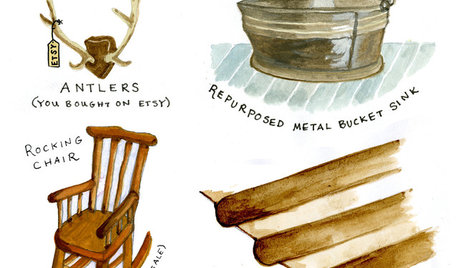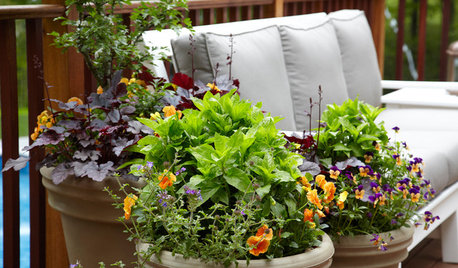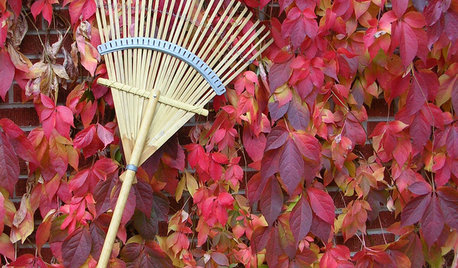Tilling vs non-tilling
urbanminimalist
12 years ago
Featured Answer
Sort by:Oldest
Comments (53)
TheMasterGardener1
12 years agolast modified: 9 years agourbanminimalist
12 years agolast modified: 9 years agoRelated Discussions
Weed killer vs. raking/tilling
Comments (2)This area gets plenty of water. This area had some grass removed 5 months ago for underground drinage pipe. The weeds took over after that. The weeds are broadleafed. Thanks for any help....See MoreTo Till...or not to Till
Comments (20)I think we've visited this subject before. Utilizing raised beds will accomodate planting in soils with poor drainage, but that is far from being the "primary" reason folks plant in raised beds. Probably the biggest reason people garden in raised beds is increased productivity - one is able to double crop yields in a raised bed garden. But there lots of other reasons why these are so popular and it has nothing to do with drainage: * The growing season is extended - the soil in raised beds warms up faster in spring and retains that warmth longer in fall, increasing the harvest period. * Raised beds are easier to maintain. Intensive planting allows for less weed development and what weeds there are are easier to reach and remove. Since you don't walk on raised beds there is no chance of soil compaction, which destroys soil structure and reduces yields. * Raised beds allow for less water usage than open cropping, a huge benefit for those that garden under drought conditions or summer water restrictions. *Raised beds are a huge boon for aging gardeners or those with physical impairments that prevent bending, kneeling or heavy digging. And since raised beds are typically accessible from both sides, they are able to be tended with very lightweight handtools. * Raised beds offer the opportunity to control plantings - either by restraining overly aggressive spreaders or by placing plants beyond the reach of pests like rabbits (very easily fenced off). * Since the soil in raised beds is imported, one is more able to adjust soil for specific growing conditions than you can in open plantings. They are ideal for growing acid loving plants in areas with more base or alkaline soils, as pH in raised beds is more easily adjusted and less buffered. * In addition to offsetting the drainage issues involved with heavy or clay soils or low areas where water may accumulate, raised beds allow the possibility of planting in other less-than-ideal conditions, like where there is a preponderance of tree roots or the soil is extremely rocky or sandy. Posting a very narrow and very personal view on the reasons for utilizing raised beds is of no benefit to anyone on these forums. We all need to a bit more openminded and receptive to possibilities beyond our own narrow frame of reference....See MoreSoil Prep New Raised Beds -- Till vs. Lasagna
Comments (7)There's no need to use vermiculite. Idaho gardener mentioned sulfur and coffee grounds to combat the high pH that is fairly common in the intermountain west. since you're planting in a lasagna garden, the pH of the soil won't be a factor. Although coffee is acidic, the acid is water soluble, so the acidity ends up in the cup and the grounds are pretty close to neutral. You should also test the soil before doing anything about pH. Although most of the intermountain west has high pH soil, My understanding is that there are some places in and around Denver that have acidic soil (I think I read that it has to do with something in the granite)....See MoreCompost - Tilling in VS Topdressing II
Comments (8)I did what you suggest over some heavy clay against a fence and filled along the fence with pure compost. I planted okra. Granted, earlier we had many, many days over 100 degrees, but if I had not watered DAILY I would have no okra. High OM content compost drinks quickly but also evaporates quickly, just as sand would. On top of heavy clay, little of the water applied to the compost had a chance to really penetrate the clay. Tilling the OM into the clay opens it up, allowing better rooting, more water absorption and oxygen penetration. Now it has cooled down, and because I have "spoiled" plants that basically didn't have to root out except in the layer of compost, I still have to water every other day. Point is, if I had of tilled the OM down the okra would have done much better with less water. When frost gets the okra I will turn in the earlier layer and add another, turning it in as well. If you have heavy clay and want productive growth the way it must be dealt with is different. Guess that's the way I see it. hortster...See Morepeter_6
12 years agolast modified: 9 years agobayoufilter
12 years agolast modified: 9 years agopnbrown
12 years agolast modified: 9 years agonovascapes
12 years agolast modified: 9 years agoZoysiaSod
12 years agolast modified: 9 years agojolj
12 years agolast modified: 9 years agoZoysiaSod
12 years agolast modified: 9 years agoZoysiaSod
12 years agolast modified: 9 years agoZoysiaSod
12 years agolast modified: 9 years agonovascapes
12 years agolast modified: 9 years agopnbrown
12 years agolast modified: 9 years agomarshallz10
12 years agolast modified: 9 years agowayne_5 zone 6a Central Indiana
12 years agolast modified: 9 years agopeter_6
12 years agolast modified: 9 years agowayne_5 zone 6a Central Indiana
12 years agolast modified: 9 years agoKimmsr
12 years agolast modified: 9 years agonovascapes
12 years agolast modified: 9 years agopeter_6
12 years agolast modified: 9 years agopnbrown
12 years agolast modified: 9 years agonovascapes
12 years agolast modified: 9 years agopnbrown
12 years agolast modified: 9 years agonovascapes
12 years agolast modified: 9 years agomarshallz10
12 years agolast modified: 9 years agonovascapes
12 years agolast modified: 9 years agomaplerbirch
12 years agolast modified: 9 years agoKimmsr
12 years agolast modified: 9 years agonovascapes
12 years agolast modified: 9 years agoKimmsr
12 years agolast modified: 9 years agomaplerbirch
12 years agolast modified: 9 years agowayne_5 zone 6a Central Indiana
12 years agolast modified: 9 years agonovascapes
12 years agolast modified: 9 years agowayne_5 zone 6a Central Indiana
12 years agolast modified: 9 years agopeter_6
12 years agolast modified: 9 years agonovascapes
12 years agolast modified: 9 years agowayne_5 zone 6a Central Indiana
12 years agolast modified: 9 years agomarshallz10
12 years agolast modified: 9 years agonovascapes
12 years agolast modified: 9 years agowayne_5 zone 6a Central Indiana
12 years agolast modified: 9 years agomaplerbirch
12 years agolast modified: 9 years agonovascapes
12 years agolast modified: 9 years agowayne_5 zone 6a Central Indiana
12 years agolast modified: 9 years agomaplerbirch
12 years agolast modified: 9 years agonovascapes
12 years agolast modified: 9 years agomaplerbirch
12 years agolast modified: 9 years agoralleia
12 years agolast modified: 9 years agonovascapes
12 years agolast modified: 9 years agoralleia
12 years agolast modified: 9 years ago
Related Stories

HOME TECH7 Ways to Charge Up and Connect After Disaster
Products and tips for communicating and keeping essential items running till the power's back on
Full Story
RUSTIC STYLE12 Must-Haves for an Instantly Rustic Home
No need to wait around for just the right hand-me-downs and woodsy finds — with these pieces, you can fake it till you make it
Full Story
MUDROOMSRoom of the Day: This Mudroom Is Just Plain Hot
Wait till you see what’s behind the hooks and bins in this genius family drop zone
Full Story
FLOWERS8 Knockout Flowers for a Fall Container Garden
Your cups will overfloweth with color and interest this fall when you plant these vivid seasonal garden classics
Full Story
GARDENING AND LANDSCAPINGWhat's in Your Garden?
Beautiful blooms, lush vegetation, maybe even a surprise or two ... we'd love to see what's happening in your landscape this month
Full Story
GARDENING GUIDESGardening Solutions for Dry, Sandy Soils
Has your desert or beachy site withered your gardening creativity? Try these ideas for a beautiful, easy-care landscape
Full Story
SHOP HOUZZHouzz Products: Innovative Things to Make You Say, ‘Wow’
Meet the problem solvers, the delightful finds and other models of great, creative design
Full Story
HOLIDAYS7 Quick and Easy Indoor Halloween Decorating Ideas
Make a pumpkin family portrait — no carving! — and other simple but eye-catching fall tabletop and mantel arrangements
Full Story
GARDENING GUIDESYour November Garden Checklist
What to do around the U.S. this month to help your garden thrive — when you're not admiring fall's brilliant colors, that is
Full Story
DECORATING GUIDESHot Looks From the Spring 2013 High Point Market
Get an eyeful of some of the colors, textures, materials and more taking a big stand at North Carolina's huge furnishings trade show
Full Story



catherine_nm